Mar 032018
I was all set up to image SpaceX’s Tesla interplanetary roadster but the weather prevented that while it was still bright enough for my equipment to see. When the clouds finally cleared, as usual, the Moon was only a couple of days from being full. The Moon’s brightness when full totally washes out the dark sky so, I reconfigured the PTO for planetary/lunar imaging and took the opportunity to shoot some images along the Moon’s terminator.
The large crater visible below is Gassendi, a 68 mile wide crater on the border of Mare Humorum (Sea of Moisture). A gap in the crater’s wall allowed the lava flow that formed the Mare to fill the crater floor leaving only the rim and central peaks still visible. There are several rille (Rimae Gassendi) visible on the crater floor where the surface cracked as the material cooled. The very small crater just below Gassendi’s central peaks is Gassendi P. The small crater has a diameter of 1 mile, giving you an idea of the image’s scale.
The crater is named after Pierre Gassendi (1592-1655), a French philosopher, priest and astronomer.

The crater was one of two alternate landing sites for Apollo 17 but it could not be determined if the terrain was too tough or dangerous for the astronauts to accomplish their primary mission of sampling rocks at the central peak.


